
Repeated bouts of colic can also be signs of enterolith stones. If your horse suffers from repeated colic ask your vet if stomach ulcers or enterolith stones may be a culprit.
Equine Solutions Catalog - COLIC in Horses

Colic is the first indicator that your horse might have an enterolith. The symptoms may worsen as the large intestine becomes loaded with gas. Colic symptoms are:
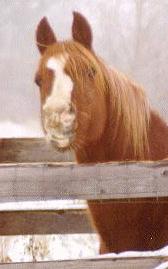
He loved to make faces.
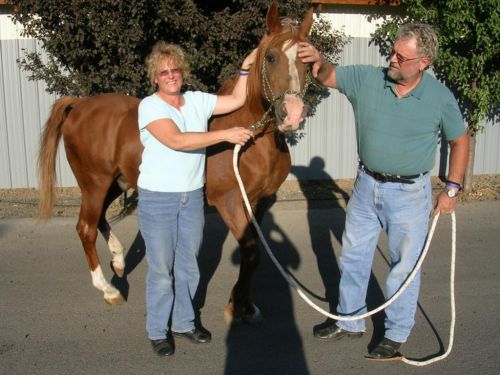
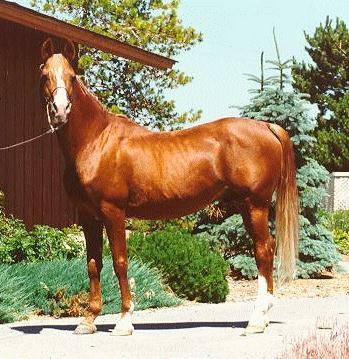
30 Years Old sired his last filly ----------------------------------------------16 Years Old
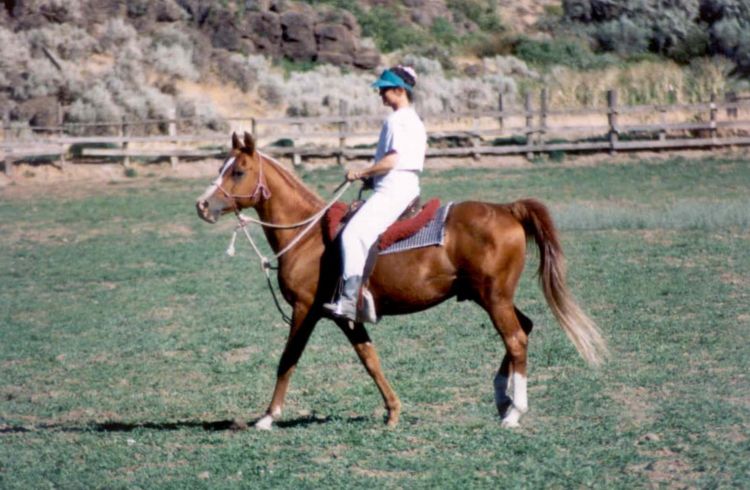
In Memory of MHR Port Dante - DANNY April 25. 1977 to Sept 11, 2010 (9-11) 33 1/2 years old
I loved this stallion so much! He was awesome!
Smart, Loved his People, Flashy, showy, energetic, talkative, expressive, prancy, obedient,
I can't say enough good about him.
And in his last 2 years he had bouts where he was down, with what appeared to be impaction colic, that would last
from 4 hours to 12 hours. We got him
cleaned out by hand, mineral oiled, banamined, probi....And at some point during the process we finally got to
the culprits, a handfull of small hard and brown apples.
We finally stalled him at nite to not have him go down by surprise out in his field and get under the fence and
stuff.
I figured out that if he didn't drink much water from his bucket that nite, I could potentially expect to find
him down the next morning.
So we had our water tested. Gave him IONS and of course his feed mix was always hydrated.
In between these bouts which were far between and not expected at first....as he had only been down once in his
life with colic
and cleared up just fine with banamine, probi and mineral oil that I orally syringed, this was maybe 1998 and the
next morning there was plenty of fresh poop
in his stall, my vet said it could take up to 12 hours. He was up after the banamine took effect and went back
to his food happily.
Danny's stools were always PERFECT and never colicy.
There was never another episode until he was 31. After reading the symptoms below....I have come to believe a stone
must have been the issue here. Too old for surgery and during the last month he didn't want to eat much, I switched
to SR feed when he refused my feed and he ate that for a little while and then only
his alfalfa hay and fresh grass. I was frantic trying to keep him eating and of course alfalfa hay was likely
the culprit only making it worse, grow bigger possibly, and alfalfa hay is all he wanted to eat....and of course
it makes
for easier pooping than other hays so I let him have it. After each episode was over, he would get up,
get his balance and footing and prance around so happy to be up and pain free again.
He had been on ABC PLUS at maintenance dose since I first brought him
home at age 16.
I had the Free Choice Stress System out for him and he never touched
it until his last couple of years.
He ate lots of A mix, then BVC mix, then Ts mix in that order. A little of the MOP
and some
Rushcreek Mineral and Redmond Salt. He would eat the white salt blocks too.
He stopped after about a year 1/2 and went to eating lots of dirt in his enclosure, biting the dirt
and digging in with his teeth for about 5 months. Then that stopped as well.
I gave him Probi, did a couple rounds of Equine Target Factors, Super Vits Plus, everything in my arsenal
plus some. I even orally syringed Mineral Oil once a week for a while.
I'm sharing these behavior/symptoms to help others. I do recall some yawning going on as mentioned
below in the symptoms towards the last period of time. When he was "down" and going through
an episode, he would stretch out all 4 of his legs and many of the other symptoms below and bloat up hard,
no passing of gas until we got some of the green poop out and he would pass gas often
as we waited for the hand full of hard, brown apples to surface.
Everything before that was perfect formed wet green apples. Another odd symptom,
was in the last year he had a light grey flakes all over his anus, I just thought maybe
dry skin due to age. I have checked my 35 yo mare and a 26 yo mini and no one else
here has that. So, it could have been from somekind of secretion-related to his issue......
This is why I'm sick. Now I find this info! After he had lost weight from not eating enough in his
last month and going down again...and we knew that time he didn't have the strength to get up
again even when we got him cleaned out. So with pain meds and had the vet out to let him go to sleep and go to
heaven.
Only IF I had known about 2 years earlier, I could have stopped the alfafla when he was still in great conditon
and found another way to keep his weight on him, he might still be here. Only If.....
For some reason....no one was even suggesting this. I never found any stones in his pasture, corral, stall....but
based on
the symptoms I don't know what else it could have been......maybe...maybe not.
He didn't have any "edema" issues.
(I have a gelding that had edema all along his sides and his
football size sheath -this came
on over about 3 years - vet said a salt block - or steroids - then he foundered mildly on alfalfa hay, so I switched
everyone over to grass hay and his edema didn't start to go away until 6 months later I put
him on the ABC Cushings supp with magnesium/chromium to help control hormones and
blood sugar levels for IR. Over the next 2 years his side edema and sheath went down to normal again.)
At first it only happened twice in the first year, then it was 6 to 9 months later again, then 4 - 5 months inbetween
then finally 2 months....
He got at first wheat bran added to his food as suggested, then switched to psyllium, slippery elm, 1 flake of
alfalfa and 1 flake of grass hay 2 X daily.
I took him off alfalfa in 2005 when 3 of my 10 horses foundered on it. I got 1/2 grass and 1/2 alfalfa from my
grower for years,
and then the last 1 or 2 months of each season he would run out and send me straight alfalfa. I didn't want that,
but what are you gonna do
when it's all you can get. Danny was the only horse to lose too much weight on straight grass hay so I for him
only added back
in 1 flake 2 X daily with his grass hay and my feed mix. He was a perfect weight before, no founder issues, no
IR issues so I thought it was ok.
His weight came back up and he did great from 2007 to 2009 and then had his first episode that was so mild appeared
to only be gas colic, walked him out of it and a nice poop. All was well. His weight and level of health remained
awesome
until his appetite became odd in 2010 about May due to a sore tooth on his right jaw which we had the vet address,
then he was ok again until he started not finishing his feed a few months later, eating dirt, began to slowly lose
weight
until he lost quite a bit the last month when he was only eating hay and basically refused any "feed mix"
Sr. or otherwise.
We got an Equine Massager, which he really enjoyed to help with his gastric
issues, we were told by an Equine
Massage Therapist that massage is very good for the flow of everything.
We did a fecal check, all was well there. We had stopped chemical wormers 1995 and vaccines in 2003 and
used ABC NOMS, Parasite Tonic and then switched to ESR Herbal Wormer 5
days on the full moon.
In 2006 we began using Homeopathic NOSODES as alternatives to vaccines.
Danny was very healthy.
We did everything we could do at his age, except for pull the possible culprit, Alfalfa Hay 2 years earlier
at first signs of something not right and of course not add the suggested Wheat Bran for fiber.
He has his own pasture during the summer months to free graze during the day and supplement his hay and feed mix.
Danny age 33 in 2010 This was spring time before Sept 9-11 His weight was great!
I loved hugging this horse! He just felt so satiny and wonderful and he loved to be hugged.
NO ONE I ASKED INCLUDING MY VET EVER SUGGESTED STONES. It was suggested due to his age "lowered gut function".
Maybe that is all it was. Maybe not.......
That is why I'm putting this info out there to potentially help someone else avoid loosing your horse no matter
his/her age.
So in loving memory of my Beloved DANNY. I hope this helps someone else and your horse avoid going to heaven due
to this.
Repeated bouts of colic can also be signs of enterolith stones. If your horse suffers from repeated colic ask your
vet if stomach ulcers or enterolith stones may be a culprit.
Colic is the first indicator that your horse might have an enterolith. The
symptoms may worsen as the large intestine becomes loaded with gas. Colic symptoms are:
• Refusal to eat grain or hay
• Change in attitude
• Restlessness
• Pulse, respiration rate, or temperature may be slightly elevated
• Glancing back at the sides of the barrel
• Kicking at the stomach
• Pawing or foot stomping
• Yawning
• Standing in a stretched position
• Tail switching
• Stumbling
• Groaning or sighing
• Repeated laying down
• Stretching of the legs while laying
• Attempting to roll
Horses with enterolithiasis may also be sluggish, unwilling to work or exercise, be thin and unthrifty and have
occasional loose bowel movements.
Repeated bouts of colic can also be signs of enterolith stones. If your horse suffers from
repeated colic ask your vet if stomach ulcers or enterolith stones may be a culprit.
Stomach Ulcers in Horses - http://voices.yahoo.com/stomach-ulcers-horses-494737.html?cat=70
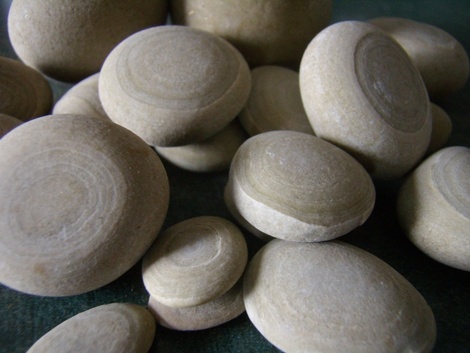
enterolith stones
http://www.learningabouthorses.com/savvy/bezoar_arsenic.html
Enteroliths or bezoars are stones that form in the intestinal tract of horses. They are made of minerals - primarily
magnesium, ammonium and phosphate.
The stones start to form when a foreign object such as a small piece of wood, twine, wire, sand or even a piece
of hair becomes wrapped in concentric rings of minerals.
When a horse has an enterolith he has a condition called enterolithiasis. (Say that fast three times!)
The cause of the stone formation is under constant research. At this time it is believed that enterolithiasis is
caused by several factors: genetic, environment and diet.
Researchers at UC - Davis have identified three genes that may be associated with enterolithiasis. Records have
also shown that Arabians and Arabian crosses are more prone to develop enteroliths, making up 40 percent of the
reported California cases. Warmbloods seem to be less prone to stones.
Stall confinement and lack of access to pasture decreases the risk of enterolith development. It is thought exercise
improves the mobility of the intestinal tract and grass dilutes the mineral concentration.
Research has also shown enterolithiasis is more prevalent in California and the southeastern part of the United
States. Reasons are unclear, although a common factor is the feeding of alfalfa.
Alfalfa hay has always been an element associated with the formation of enteroliths. Alfalfa is high in calcium,
magnesium and protein, which can create higher levels of mineral concentration in the large intestine.
Research has also shown a high pH (alkaline) level within the cecum (part of the large intestine) is associated
with enterolithiasis. Creating a more acidic environment may be helpful in reducing the formation of enteroliths.
Adding a half cup of apple vinegar to the diet twice a day may help lower the pH level in the cecum (1,000 pound
horse).
Dietary recommendations for horses with a history of enterolithiasis or that fit the profile include offering no
alfalfa, not feeding wheat bran (high in phosphorus), adding apple vinegar to the diet and pasture. Insuring horses
have access to fresh clean water at all times also lessens the chances of an enterolith developing.
Colic is the first indicator that your horse might have an enterolith. The symptoms may worsen as the large intestine
becomes loaded with gas. Colic symptoms are:
• Refusal to eat grain or hay
• Change in attitude
• Restlessness
• Pulse, respiration rate, or temperature may be slightly elevated
• Glancing back at the sides of the barrel
• Kicking at the stomach
• Pawing or foot stomping
• Yawning
• Standing in a stretched position
• Tail switching
• Stumbling
• Groaning or sighing
• Repeated laying down
• Stretching of the legs while laying
• Attempting to roll
Horses with enterolithiasis may also be sluggish, unwilling to work or exercise, be thin and unthrifty and have
occasional loose bowel movements.
Diagnosing enterolithiasis is difficult. The stones are usually discovered when the horse is operated on for colic. 
Enteroliths: A Cause of Colic in the Horse- http://evrp.lsu.edu/healthtips/Enteroliths-Colic.htm
What can be done to prevent enterolith formation?
Following is a list of several recommendations to help prevent enterolith formation.
These should be considered if you are in a region of the United States where alfalfa is the main roughage being
fed, such as in the Mid- West and California.
1. Decrease alfalfa hay to <50% of the horse’s ration. Grass/ oat hay may be used instead.
2. Bran has high levels of phosphorus so it should be reduced/ eliminated from your horse’s diet.
3. Increase the grain to hay ratio to decrease the pH of the intestinal tract
4. Add applecider vinegar to feed at 1 cup per day to help decrease the pH
5. Provide daily grazing or increase feedings to 3-4 times daily
6. Provide consistent and frequent exercise to keep the digestive system moving and avoid prolonged stall confinement.
7. Avoid access to foreign bodies.
Who is at risk?
Enteroliths most commonly form in horses from 5- 10 years of age, and are most often seen in Arabians and female
horses.
What causes enterolith to form?
Although the specific cause is unknown, possible causes include excessive minerals in the diet such as magnesium,
phosphate, or calcium, ingestion of foreign objects, lack of pasture grazing, and prolonged stall confinement.
Excessive alfalfa hay intake has especially been implicated in the formation of enteroliths in horses. Alfalfa
provides the gut with a large amount of minerals, including magnesium and phosphorus. Also, the alfalfa hay tends
to alkalinize (raise the pH) of the normally acidic (low pH) intestinal environment. This higher pH tends to cause
the minerals in the alfalfa to precipitate and attach to foreign bodies present in the colon, thus forming an enterolith.
It has been shown that nearly all horses experiencing enteroliths had a diet consisting of at least 50 % alfalfa
hay.
What are the clinical signs of an enterolith?
Unfortunately, there are no tell-tale signs. Most enteroliths form in the large intestine (colon). Eventually they
are pushed back into the small colon resulting in a ball- valve effect causing obstruction of fecal passage. This
results in horses usually showing persistent, mild abdominal pain of several days duration that may sometimes be
proceeded by intermittent bouts of colic. The horse may go off feed and become depressed. They will usually have
sparse, mucous covered feces, and will also be distended in the flank area.
How are enteroliths diagnosed?
As soon as you notice signs of colic in your horse, regardless of degree of pain, you should contact your veterinarian.
The veterinarian will perform a general physical exam: obtaining temperature, pulse, and respiratory rate, and
listening for the presence of gut sounds. In the case of an enterolith impaction, temperature, pulse and respiratory
rate can all be normal, however, gut sounds are usually absent (this is not, however, specific for enteroliths).
Depending on the equipment available to him, your veterinarian may also want to run some blood work in order to
obtain a clearer picture of the problem at hand. He/she will also perform a rectal palpation to feel for any distension/
displacement of bowel loops as well as any impactions. While some impactions may be palpated per rectum, unfortunately,
enterloiths often form too far forward to be felt this way. Although an important diagnostic tool, you should be
aware of the risks involved with rectal palpation. Rectal tears can occur during palpation that may lead to further
problems. A nasogastric tube may also be passed in order to check for the presence/ amount of reflux from the stomach.
The amount and consistency of material obtained further aids in the diagnosis. An abdominocentesis may also be
performed in which a needle is inserted into the abdominal cavity to obtain fluid for evaluation. In rare cases,
enteroliths may be detected with ultrasonography or radiology. Ultimately, however, most are diagnosed surgically.
What is the treatment for enterolith impaction?
Surgical removal in most cases is the only treatment. The surgery is usually performed at an equine hospital and
can be quite expensive. The horse is placed under general anesthesia and placed on his back for surgery. After
an incision is made on the horses midline, the surgeon will perform a complete exploratory on the entire intestinal
tract to locate the obstruction. An incision is made into the colon, allowing the surgeon to remove the all intestinal
contents, including the stone. Once the stone is removed, the colonic wall is closed, the intestines thoroughly
lavaged, and the abdomen is closed.
ABC's PRO BI Liquid Probiotic
for Horses,
PrePro - Equine Health Supplement
PRO BI is a biological feed additive designed to maximize digestive efficiency.
Why is Pro Bi different? How does it work?
Pro Bi is a prebiotic, not a probiotic. Pro BI is food for microflora and substrate that creates a supreme environment
for microflora to colonize and multiply at an accelerated rate.
This is why Pro Bi is so effectice. Benefits are realized rapidly and consistently. Pro Bi consists of 90% Prebiotics
(food for digestive microflora) , 5% Probiotics (digests microflora), 5% Enzymes.
Pro Bi doesn't have to be refigerated. Shelf Life is forever.
A horse's beneficial intestinal bacteria can be destroyed or depleted and the pH of their environment can be altered during times of stress. Competion, travel and breeding or treatment with antibiotics, dewormers and other medications can cause this stress. Stress can also be created by alterations of weather, environment, feeds and water.
Without the beneficial intestinal bacteria, food ferments instead of being digested. Undigested foods may then lead to situations of colic, bloat, founder and increase the possibility of developing allergic conditions. PRO BI contains a natural fermented extract plus a number of herbs, such as Ginger, Peppermint, Dandelion and Violet Leaves which nourish the natural bacteria and encourages them to reproduce and multiply at a rapid rate. Most bacteria reproduce every 15 minutes, so it is possible to speed recovery of a colic case or even treat some simple colics entirely with PRO BI.
PRO BI is the benefit of microbials; no waiting, It Just Works! Best of all no worry
about shelf life.
Ingredients: Lactobacillus Acidophilus Fermentation Product, Alo Vera, Chlorophyll Liquid, Peppermint, Ginger,
Dandelion and Violet Leaves in a proprietary blend.
THE DIGESTIVE TRACT FIRST AID KIT -- NEVER BE WITHOUT IT!
WHEN & HOW TO USE:
Also good for dogs and cats. Dogs: 20 drops initially orally or with feed, and 10 drops thereafter.
Cats: 10 drops initially orally or with feed, and 5 drops thereafter.
Feel safe, you can't overdo, just make sure they can swallow it without choaking because you put too much in their
mouth.
Before and during travel, throughout competitions, with de-wormers, antibiotic therapy, and alterations of feed, water and/or environment:
5cc (ml) twice daily, orally or with feed.
At any sign of or suspicion of digestive disorders (including diarrhea):
10cc (ml) orally, immediately. Thereafter, 5cc (ml) twice daily until signs of the disorder subside.
Colic: Administer orally, 1 oz. (3Occ), immediately, and then contact
your local veterinarian.
FOALS: Administer 5cc (ml) shortly after birth.
SKU: 8152OZBTL Equine PRO BI™ - 2 OZ Bottle Advanced Biological Concepts®
PRICE: $21.11 after 5% disc $20.05
PRO BI™ is a biological feed additive designed to mazimize digestive ifficiency. A horse's beneficial intestinal
bacteria can be destroyed or depleted and the pH of their environment can be altered during times of stress. Competition,
travel, breeding, treatment with antibiotics, de-wormers and other medications can cause this stress. Stress can
also be created by alterations of weather, environment, feed and water.
Item No.81516OZBTL Size: 16 ounces
Item No. 8151GALBTL Size: 1 Gallon
Current Pricing is listed in the Shopping Cart.
See Catagories on the Left Side in alphabetical order, as they are links to sizes and prices and
the BUY NOW button. Click on the little blue grocery bag.
Quick! Take Me To The Shopping Cart & Check Out!... 

NOTE on more PRO BI uses:
1) For sores (ulcer type) that won't heal, you can apply PRO BI, it will often induce healing.
2) It has shown some success on healing stubborn scratches.
3) For fungus or eye infections; dilute four parts distilled water to one part PRO BI and use as eye drops.
4) Has been used for persistent fungus of the sheath.
I personally keep Probi on hand and use it for colic episodes, after antiobiotics
for a few days to a week to
put back the friendly flora killed off by antiobiotics (if you use chemical wormers still you should use it
after that and vaccinations), I use it on my cats and dogs to settle their tummies
and after antiobiotics, clear up vomiting or diarreah. It's like GOLD to me.
If you are looking for an everyday solution for digestive problems, ulcers, lack of absorption of
nutrients etc... use the ABC Plus or the Equine-Zyme. Both are excellant Digestive Aids for daily top dressing. Vickie Stevens
![]()
Proflora #306-1D Price : Human grade of the Pro Bi. NO LONGER AVAILABLE
1 fl.oz.
21.63 Plus Actual Freight
Proflora provides synergistic nutritional and botanial support to optimize the growth of beneficial flora, inhibit
pathogenic or abnormal flora, and soothe irritated intestinal mucosa.* Proflora is recommended during and after
the use of anti-pathogenic supplements or antibiotics. It is a mild tasting liquid perfect for the whole family,
and unlike many probiotic combinations, does not require refrigeration.
Equilite's PrePro - Equine
Health Supplement 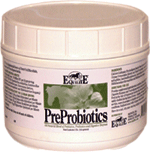
PreProbiotics A blend of direct fed microbials
important to support healthy digestive processes.
Crucial to an animal’s gut are the “friendly bacteria” for mircorbial balance.
Prebiotics (Fructooligosaccharides FOS) are added to help increase the nutrients needed for specific bacteria to
survive.
Digestive enzymes are used to help break down food for proper digestion and absorption.
Wonderful to use before and after worming or antibiotic protocols. An average size horse uses 10 grams per day.
Size
Item 1 lb. (PrePro - Equine Health Supplement)
Item 4 lb. (PrePro - Equine Health Supplement)
Current Pricing is listed in the Shopping Cart.
See Catagories on the Left Side in alphabetical order, as they are links to sizes and prices and
the BUY NOW button. Click on the little blue grocery bag.
Quick! Take Me To The Shopping Cart & Check Out!... 
"I would have no qualms giving Pre Probiotics to my own horses if I had a Cushing's horse. I also have SEVERAL
clients with Cushing's horses giving Pre Probiotics with the animal only improving. FOS's actually support gut
health which supports upper GI and pancreatic health. Human diabetic patients have no problems taking FOSs (eg
no change in insulin needs when taking it). It is a complex fiber that does not cause blood sugar spikes."
Kim Henneman, DVM, CVA, CVC
"I gave one of my clients the Pre Probiotics. She has an old mare, 24 years old, that has numerous melanomas.
She has been having digestive problems, especially diarrhea. The vet recommended that she be put on probiotics,
so we started using your Pre Probiotics with her. There has been a definite improvement. She is not nearly as 'runny'.
My client is very impressed."
Kristy Limon, Eventer, Magnolia TX
See More about ProBiotic Microbial Benefits- Go here...![]()
Use the Navigation Bars for quick and easy access.
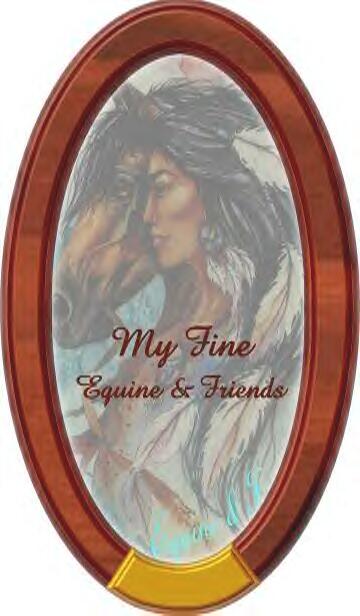
You can contact us by Snail Mail at: